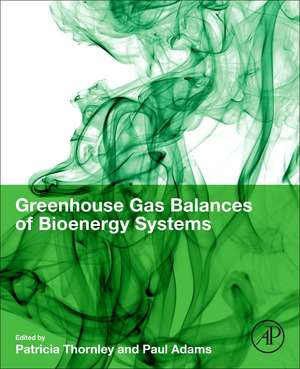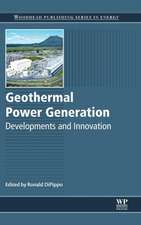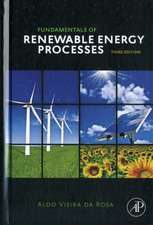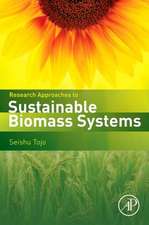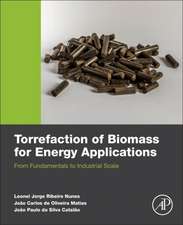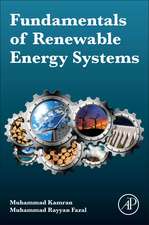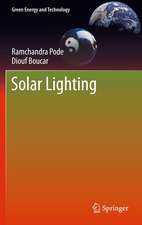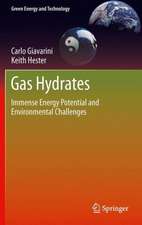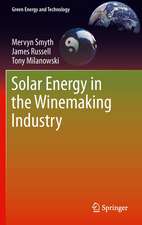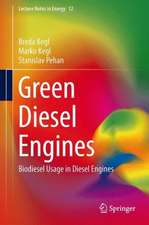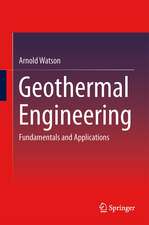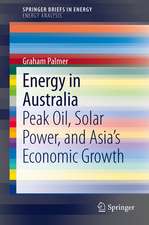Greenhouse Gas Balances of Bioenergy Systems
Editat de Patricia Thornley, Paul Adamen Limba Engleză Paperback – 27 noi 2017
Its expert chapter authors present readers to the methods used to determine the greenhouse gas balance of bioenergy systems, the data required and the significance of the results obtained. It also provides in-depth discussion of key issues and uncertainties, such as soil, agriculture, forestry, fuel conversion and emissions formation. Finally, international case studies examine typical GHG reduction levels for different systems and highlight best practices for bioenergy GHG mitigation.
For bringing together into one volume information from several different fields that was up until now scattered throughout many different sources, this book is ideal for researchers, graduate students and professionals coming into the bioenergy field, no matter their previous background. It will be particularly useful for bioenergy researchers seeking to calculate greenhouse gas balances for systems they are studying. I will also be an important resource for policy makers and energy analysts.
- Uses a multidisciplinary approach to synthesize the diverse information that is required to competently execute GHG balances for bioenergy systems
- Presents an in-depth understanding of the science underpinning key issues and uncertainty in GHG assessments of bioenergy systems
- Includes case studies that examine ways to maximize the GHG reductions delivered by different bioenergy systems
Preț: 688.08 lei
Preț vechi: 900.61 lei
-24% Nou
Puncte Express: 1032
Preț estimativ în valută:
131.68€ • 142.98$ • 110.61£
131.68€ • 142.98$ • 110.61£
Carte tipărită la comandă
Livrare economică 15-29 aprilie
Preluare comenzi: 021 569.72.76
Specificații
ISBN-13: 9780081010365
ISBN-10: 0081010362
Pagini: 286
Dimensiuni: 191 x 235 x 19 mm
Editura: ELSEVIER SCIENCE
ISBN-10: 0081010362
Pagini: 286
Dimensiuni: 191 x 235 x 19 mm
Editura: ELSEVIER SCIENCE
Cuprins
1. Climate Change: a bioenergy driver and constraint
2. Policy mechanisms
3. The role of life cycle assessment
4. Scope of system for analysis
5. Carbon sequestration
6. Accounting for Greenhouse Gas Balances Associated with Land-Use
7. Harvesting, Processing and Transporting Biomass
8. Conversion technologies
9. End-Uses
10. Anaerobic Digestion of Farm Slurry and Residues for Gas Grid Injection
11. Biodiesel from Argentinian Soy
12. Combustion of Energy Crop Pellets for Home Heating
13. Production of Wood Pellets from Wood Waste
14. Second Generation Ethanol from Ligno-Cellulose
15. Electricity from north American forest residues
16. Agricultural Lessons
17. Engineering Lessons
18. Environmental Lessons
19. Policy Lessons
20. Outlook
2. Policy mechanisms
3. The role of life cycle assessment
4. Scope of system for analysis
5. Carbon sequestration
6. Accounting for Greenhouse Gas Balances Associated with Land-Use
7. Harvesting, Processing and Transporting Biomass
8. Conversion technologies
9. End-Uses
10. Anaerobic Digestion of Farm Slurry and Residues for Gas Grid Injection
11. Biodiesel from Argentinian Soy
12. Combustion of Energy Crop Pellets for Home Heating
13. Production of Wood Pellets from Wood Waste
14. Second Generation Ethanol from Ligno-Cellulose
15. Electricity from north American forest residues
16. Agricultural Lessons
17. Engineering Lessons
18. Environmental Lessons
19. Policy Lessons
20. Outlook
